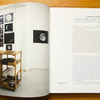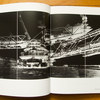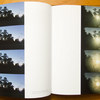Review: Vera Lutter

Photography ultimately is about time, to be precise about time stopped, time brought to a standstill. Mathematically thinking, this time is an accumulation, though: You expose your piece of film (or your digital chip) for a fraction of a second, which means that whatever happens in that short moment impresses itself onto the image. We tend not to think of it that way, because our own consciousness cannot comprehend very short moments in time, and our eyes can’t see them. We see 24 distinct images in a second, and we think something is moving. The only chance we have to see that photography captures periods in time is when the time gets so long that we can start to see the accumulation. Funky as it is, photography, however, doesn’t work that simply either, because if you require too long an exposure, photography will simply refuse to register the short moments (phrasing it this way makes it more interesting than saying “will be unable”). In one of Louis Daguerre’s earliest photographs, what would or rather should have been a busy street scene is transformed into an almost empty space, with only two humans visible (have a look).
With her photography, Vera Lutter has been exploring this aspect of photography for quite some time now. Produced with a camera-obscura technique, Lutter’s images are negatives - they never get to leave that negative space, that anteroom of photography, so well known from analogue photography. The combination of long exposures and negative photographic space turns the artist’s images (I’m sure many people would not even think of them as “photographs”) into other-worldly beings, and in a sense, they are: It is almost as if there was at least one other reality besides ours, a world inverted, where what we think matters does not, where all the little stuff we are so concerned about is mere chickenshit that doesn’t even register (this realization might draw shivers on the spines of frequent social-media users).
It is interesting how Lutter’s photographs do not look all that different from Michael Wesely’s, even though the latter’s images are positives (cliche alert: They’re both German! Who’ll bite?). It is as if that other world had a very specific look and feel, too - just like ours. What else is there, though, besides the technical exercise, in Lutter’s (or Wesely’s) images? Vera Lutter, a new book summarizing the artist’s career, attempts to investigate and explain. Produced at the occasion of an exhibition at the Carré d’Art - musée d’art contemporain in Nîmes (France), the book comprises a large number of the artist’s images plus selected in-depth essays by various authors.
Elegantly designed and produced, the book showcases the work, while it provides some insight into what might be behind it. It certainly is one of the better books coming out of major exhibitions dedicated to photographers that I’ve seen lately. For example, I found the books produced at the occasions of Cindy Sherman at MoMA and Rineke Dijkstra at SFMoMA oddly (and sadly) lacking in both production quality and content (from talking to other people I’m not alone with this sentiment). Fortunately, there are books like Vera Lutter or Sally Mann - The Flesh and the Spirit that demonstrate that major retrospectives can indeed come with publications that do the artists’ work and achievement justice, while looking and feeling engaging and contemporary.
Vera Lutter, photographs by Vera Lutter, essays by Francoise Cohen, Douglas Crimp, Steven Jacobs, Gertrud Koch, 144 pages, Hatje Cantz, 2012







